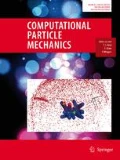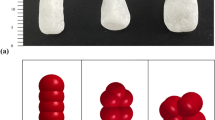Abstract
In the interaction between rubber tire and granular terrain, the dynamic behavior of granular terrain is significantly affected not only by the shape of soil grains, but also by the deformation contact of tread rubber. Therefore, the effect of these two factors should be considered in tire–sand interactions. In this study, an improved contact model including the effect of sand grain shape and tread rubber deformation is developed for dealing with the interaction between rubber tire and sand terrain. In sand–sand contact model, the interaction between sand grains takes the form of surface contact instead of conventional point contact, where the contact calculation contains four interactions, i.e., normal force, tangential force, rolling resistance and twisting resistance. And in tread–sand contact model, the contact between tread rubber and sand grains is surface contact, which includes the rolling resistance and twisting resistance on the grains caused by rubber deformation during contact. As a result, the complete and realistic evaluation of contact forces is accomplished. Next, a comparison of sandpile simulation of coarse particles and experiment is carried out to verify the effectiveness of the sand–sand contact model. Finally, the novel contact model is applied to tire–sand interaction simulations and compared with the single-wheel experiments. The results indicate that the proposed contact model can be a powerful tool to simulate the interactions between rubber tire and sand terrain.
























Similar content being viewed by others
References
El-Sayegh Z, El-Gindy M, Johansson I et al (2018) Improved tire–soil interaction model using FEA-SPH simulation. J Terrramech 78:53–62
Cueto OG, Coronel CEI, Morfa CAR et al (2013) Three dimensional finite element model of soil compaction caused by agricultural tire traffic. Comput Electron Agric 99:146–152
Xia K (2011) Finite element modeling of tire/terrain interaction: application to predicting soil compaction and tire mobility. J Terrramech 48(2):113–123
Hernandez JA, Al-Qadi IL (2016) Semicoupled modeling of interaction between deformable tires and pavements. J Transp Eng Part A Syst 143(4):04016015
Li H, Schindler C (2013) Analysis of soil compaction and tire mobility with finite element method. Proc Inst Mech Eng Part K J Multi-body Dyn 227(3):275–291
Rubinstein D, Shmulevich I, Frenckel N (2018) Use of explicit finite-element formulation to predict the rolling radius and slip of an agricultural tire during travel over loose soil. J Terrramech 80:1–9
Yamashita H, Jayakumar P, Alsaleh M et al (2018) Physics-based deformable tire–soil interaction model for off-road mobility simulation and experimental validation. J Comput Nonlinear Dyn 13(2):021002
Ozaki S, Kondo W (2016) Finite element analysis of tire traveling performance using anisotropic frictional interaction model. J Terrramech 64:1–9
Behnke R, Wollny I, Hartung F et al (2019) Thermo-mechanical finite element prediction of the structural long-term response of asphalt pavements subjected to periodic traffic load: tire–pavement interaction and rutting. Comput Struct 218:9–31
Smith W, Peng H (2013) Modeling of wheel–soil interaction over rough terrain using the discrete element method. J Terrramech 50(5–6):277–287
Du Y, Gao J, Jiang L et al (2017) Numerical analysis of lug effects on tractive performance of off-road wheel by DEM. J Braz Soc Mech Sci Eng 39(6):1977–1987
Du Y, Gao J, Jiang L et al (2018) Development and numerical validation of an improved prediction model for wheel–soil interaction under multiple operating conditions. J Terrramech 79:1–21
Jiang M, Dai Y, Cui L et al (2018) Experimental and DEM analyses on wheel–soil interaction. J Terrramech 76:15–28
Nakashima H, Takatsu Y, Shinone H et al (2009) FE-DEM analysis of the effect of tread pattern on the tractive performance of tires operating on sand. J Mech Syst Transp Logist 2(1):55–65
Nishiyama K, Nakashima H, Yoshida T et al (2016) 2D FE–DEM analysis of tractive performance of an elastic wheel for planetary rovers. J Terrramech 64:23–35
Nishiyama K, Nakashima H, Shimizu H et al (2017) 2D FE–DEM analysis of contact stress and tractive performance of a tire driven on dry sand. J Terrramech 74:25–33
Nishiyama K, Nakashima H, Yoshida T et al (2018) FE–DEM with interchangeable modeling for off-road tire traction analysis. J Terrramech 78:15–25
Michael M, Vogel F, Peters B (2015) DEM–FEM coupling simulations of the interactions between a tire tread and granular terrain. Comput Methods Appl Mech Eng 289:227–248
Horner DA, Peters JF, Carrillo A (2001) Large scale discrete element modeling of vehicle–soil interaction. J Eng Mech 127(10):1027–1032
Recuero A, Serban R, Peterson B et al (2017) A high-fidelity approach for vehicle mobility simulation: nonlinear finite element tires operating on granular material. J Terrramech 72:39–54
Yamashita H, Chen G, Ruan Y et al (2019) Hierarchical multiscale modeling of tire–soil interaction for off-road mobility simulation. J Comput Nonlinear Dyn 14(6):061007
Zhao C, Zang M (2014) Analysis of rigid tire traction performance on a sandy soil by 3D finite element–discrete element method. J Terrramech 55(7):29–37
Zhao CL, Zang MY (2017) Application of the FEM/DEM and alternately moving road method to the simulation of tire–sand interactions. J Terrramech 72:27–38
Zhao C, Zang M, Chen S et al (2018) Improving the 3D finite–discrete element method and its application in the simulation of wheel–sand interactions. Int J Comput Methods 15(07):1850059
Zheng Z, Zang M, Chen S et al (2018) A GPU-based DEM–FEM computational framework for tire–sand interaction simulations. Comput Struct 209:74–92
Zeng H, Xu W, Zang M et al (2019) Experimental and numerical investigations of tractive performance of off-road tires on gravel terrain. Int J Comput Methods. https://doi.org/10.1142/S0219876219500555
Nassauer B, Liedke T, Kuna M (2013) Polyhedral particles for the discrete element method. Granul Matter 15(1):85–93
Eliáš J (2014) Simulation of railway ballast using crushable polyhedral particles. Powder Technol 264:458–465
Govender N, Wilke DN, Wu CY et al (2018) Large-scale GPU based DEM modeling of mixing using irregularly shaped particles. Adv Powder Technol 29(10):2476–2490
Khazeni A, Mansourpour Z (2018) Influence of non-spherical shape approximation on DEM simulation accuracy by multi-sphere method. Powder Technol 332:265–278
Xu T, Yu J, Yu Y et al (2018) A modelling and verification approach for soybean seed particles using the discrete element method. Adv Powder Technol 29(12):3274–3290
He Y, Evans TJ, Shen YS et al (2018) Discrete modelling of the compaction of non-spherical particles using a multi-sphere approach. Miner Eng 117:108–116
Iwashita K, Oda M (2000) Micro-deformation mechanism of shear banding process based on modified distinct element method. Powder Technol 109(1–3):192–205
Jiang MJ, Yu HS, Harris D (2005) A novel discrete model for granular material incorporating rolling resistance. Comput Geotech 32(5):340–357
Jiang M, Shen Z, Wang J (2015) A novel three-dimensional contact model for granulates incorporating rolling and twisting resistances. Comput Geotech 65:147–163
Horabik J, Molenda M (2016) Parameters and contact models for DEM simulations of agricultural granular materials: a review. Biosyst Eng 147:206–225
Markauskas D, Kačianauskas R (2011) Investigation of rice grain flow by multi-sphere particle model with rolling resistance. Granul Matter 13(2):143–148
Ai J, Chen JF, Rotter JM et al (2011) Assessment of rolling resistance models in discrete element simulations. Powder Technol 206(3):269–282
Wakui F, Terumichi Y (2011) Numerical simulation of tire–ground system considering soft ground characteristics. J Syst Des Dyn 5(8):1650–1661
Matsushima T (2005) Effect of irregular grain shape on quasi-static shear behavior of granular assembly. Powders Grains 2:1319–1323
Cundall PA, Strack ODL (1979) A discrete numerical model for granular assemblies. Geotechnique 29(1):47–65
Balevičius R, Džiugys A, Kačianauskas R (2004) Discrete element method and its application to the analysis of penetration into granular media. J Civ Eng Manag 10(1):3–14
Perez JCL, Kwok CY, Senetakis K (2016) Effect of rubber size on the behaviour of sand–rubber mixtures: a numerical investigation. Comput Geotech 80:199–214
Tekeste MZ, Balvanz LR, Hatfield JL et al (2019) Discrete element modeling of cultivator sweep-to-soil interaction: worn and hardened edges effects on soil–tool forces and soil flow. J Terrramech 82:1–11
Luding S (2008) Cohesive, frictional powders: contact models for tension. Granul Matter 10(4):235
Gardiner BS, Tordesillas A (2006) Effects of particle size distribution in a three-dimensional micropolar continuum model of granular media. Powder Technol 161(2):110–121
Huang J, da Silva MV, Krabbenhoft K (2013) Three-dimensional granular contact dynamics with rolling resistance. Comput Geotech 49:289–298
Lei Z, Zang M (2010) An approach to combining 3D discrete and finite element methods based on penalty function method. Comput Mech 46(4):609–619
Zang MY, Lei Z, Wang SF (2007) Investigation of impact fracture behavior of automobile laminated glass by 3D discrete element method. Comput Mech 41(1):73–83
Li Y, Xu Y, Thornton C (2005) A comparison of discrete element simulations and experiments for ‘sandpiles’ composed of spherical particles. Powder Technol 160(3):219–228
Derakhshani SM, Schott DL, Lodewijks G (2015) Micro-macro properties of quartz sand: experimental investigation and DEM simulation. Powder Technol 269:127–138
Dai L, Sorkin V, Vastola G et al (2019) Dynamics calibration of particle sandpile packing characteristics via discrete element method. Powder Technol 347:220–226
Ani OA, Uzoejinwa BB, Ezeama AO et al (2018) Overview of soil–machine interaction studies in soil bins. Soil Tillage Res 175:13–27
Hallquist JO (2007) LS-DYNA keyword user’s manual, vol 970. Livermore Software Technology Corporation, California, pp 299–800
Syed Z, Tekeste M, White D (2017) A coupled sliding and rolling friction model for DEM calibration. J Terrramech 72:9–20
Zhuang J (2002) Computational vehicle terramechanics. Press of Mechanical Industry, Beijing (in Chinese)
Hambleton JP, Drescher A (2009) Modeling wheel-induced rutting in soils: indentation. J Terrramech 46(2):35–47
Acknowledgements
This work was supported by the National Key R&D Program of China (No. 2017YFE0117300), the Science and Technology Planning Project of Guangzhou (No. 201804020065), the National Natural Science Foundation of China (No. 11672344).
Author information
Authors and Affiliations
Corresponding author
Ethics declarations
Conflict of interest
The authors declare that they have no conflict of interests.
Additional information
Publisher's Note
Springer Nature remains neutral with regard to jurisdictional claims in published maps and institutional affiliations.
Rights and permissions
About this article
Cite this article
Yang, P., Zang, M. & Zeng, H. DEM–FEM simulation of tire–sand interaction based on improved contact model. Comp. Part. Mech. 7, 629–643 (2020). https://doi.org/10.1007/s40571-019-00293-6
Received:
Revised:
Accepted:
Published:
Issue Date:
DOI: https://doi.org/10.1007/s40571-019-00293-6




